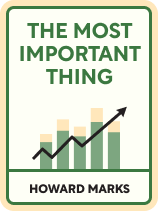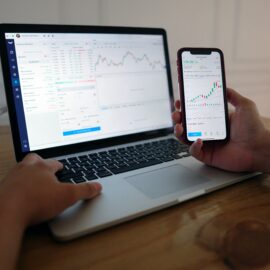

This article is an excerpt from the Shortform book guide to "The Most Important Thing" by The Princeton Language Institute and Abby Marks Beale. Shortform has the world's best summaries and analyses of books you should be reading.
Like this article? Sign up for a free trial here.
What’s the difference between value investing and growth investing? Which one’s the better investment strategy?
In his book The Most Important Thing, Howard Marks claims that growth investing doesn’t provide the same benefits as value investing. This is because value investing yields superior returns, whereas growth investing doesn’t get the same result as often.
Continue reading for a deep dive into value investing vs. growth investing.
The Differences Between Value Investing and Growth Investing
Marks explains value investing vs. growth investing by looking at their securities’ fundamentals—that is, information that reflects the financial health of a security, such as revenue, cash flow, and profit margins. He argues that value investing is superior to growth investing because it yields more consistent and dependable returns.
(Shortform note: Although Marks applies value investing more broadly to all securities—not just stocks—experts traditionally discuss value investing in the context of stock market investing alone. That is, they focus on purchasing stocks that are underpriced relative to their intrinsic value, rather than (say) purchasing underpriced corporate bonds.)
To understand growth and value investing, however, we first need to understand the notion of intrinsic value. At its core, intrinsic value refers to the fair value of a security, assuming all relevant information was factored into its price. For example, if extreme pessimism led investors to excessively sell Amazon stock at the beginning of 2023, then Amazon’s share price of $85.46 might have been lower than its intrinsic value per share.
(Shortform note: Though Marks emphasizes the importance of intrinsic value, he doesn’t specify what intrinsic value is. To that end, Robert Hagstrom’s explanation of intrinsic value in The Warren Buffett Way is useful. Hagstrom clarifies that a company’s intrinsic value is its expected net income over its lifetime, deducted by an appropriate discount rate. In other words, intrinsic value is the amount a company will profit over its lifetime in today’s dollars.)
Marks notes that value and growth investors agree that over the long term, securities’ prices roughly match their intrinsic value. However, this agreement yields different conclusions. On one hand, value investors seek out underpriced securities—those whose price is below their intrinsic value—reasoning that, as the market corrects this disparity, these securities will increase in price. On the other hand, growth investors seek securities whose intrinsic value has high growth potential—even if these securities aren’t currently underpriced—reasoning that, as their intrinsic value increases over time, so too will their trading price.
But Marks contends that it’s much more difficult to assess long-term potential than present value. Moreover, he writes that unless you’re superior to the market at identifying potential, it’s likely that this potential is already factored into the security’s price. For example, Tesla’s stock price at the beginning of 2020—$28.30 per share—likely reflected not only Tesla’s business fundamentals, but also its potential for explosive growth. In turn, he concludes that value investing generates more consistent—and less speculative—returns than growth investing, making it preferable for investors.
(Shortform note: Although Marks presents value and growth investing as if they’re mutually exclusive, some investing strategies aim to consolidate them into a single approach. In particular, a strategy known as “growth at a reasonable price,” or GARP, seeks out companies with outsized earnings potential that nonetheless appear undervalued. By investing in these companies, GARP investors purportedly enjoy the consistency of value investing and the exponential returns of growth investing.)
Value Investing and the Efficient Market Hypothesis
Marks admits that value investing requires securities’ prices to occasionally differ from their intrinsic value. But, according to many academic theorists, this market disparity between prices and intrinsic value is rare—or even nonexistent. Many theorists embrace the Efficient Market Hypothesis (EMH), which states that market prices always accurately reflect securities’ intrinsic value because all relevant information about securities is baked into their price. Marks, however, cites discrepancies between market price and value to argue that the EMH is mistaken, making value investing possible.
For the clearest discrepancy between market price and value, Marks points to Yahoo’s share price in the 16 months between January 2000 and April 2001. At first, in January of 2000, Yahoo’s share price was $237, whereas 16 months later, its share price was $11. According to Marks, it’s implausible that Yahoo’s intrinsic value dropped by over 95% in that time span—rather, he maintains that the market must have mispriced its stock at least once, meaning the EMH must be false.
(Shortform note: Yahoo’s collapse was the byproduct of the 2000 dot-com bubble bursting, in which technology stocks dropped sharply in value, leaving many internet start-ups financially devastated. Experts explain that, because such a large portion of Yahoo’s revenue stemmed from advertising for these internet companies, its revenue plummeted when these companies no longer had the funds to advertise on Yahoo’s platform.)

———End of Preview———
Like what you just read? Read the rest of the world's best book summary and analysis of The Princeton Language Institute and Abby Marks Beale's "The Most Important Thing" at Shortform.
Here's what you'll find in our full The Most Important Thing summary:
- Why the best approach to investing is value investing
- The common mistakes that expose investors to risks
- How market cycles work and how to use them to find mispriced securities






